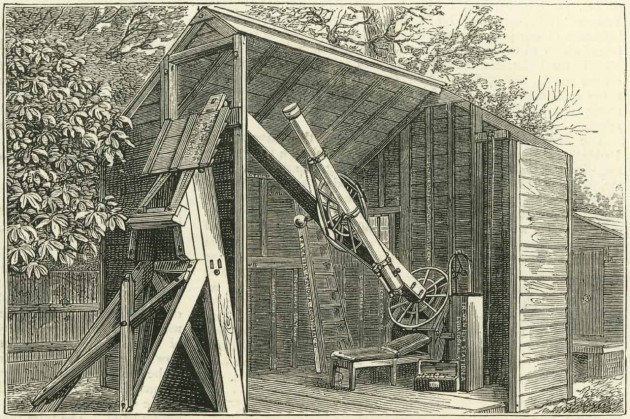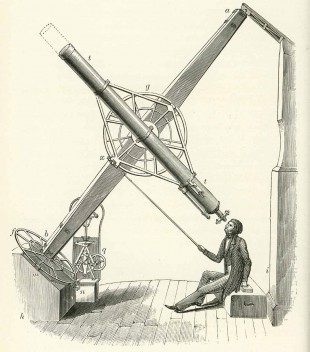…where east meets west
- Home
- Brief History
- The Greenwich Meridian
- Greenwich
(1675–1958) - Herstmonceux
(1948–1990) - Cambridge
(1990–1998) - Outstations (1822–1971)…
- – Chingford (1822–1924)
- – Deal
(1864–1927) - – Abinger
(1923–1957) - – Bristol & Bradford on Avon
(1939–1948) - – Bath
(1939–1949) - – Hartland
(1955–1967) - – Cape of Good Hope
(1959–1971)
- Administration…
- – Funding
- – Governance
- – Inventories
- – Pay
- – Regulations
- – Royal Warrants
- Contemporary Accounts
- People
- Publications
- Science
- Technology
- Telescopes
- Chronometers
- Clocks & Time
- Board of Longitude
- Libraries & Archives
- Visit
- Search
Telescope: Lee Equatorial (1829)
Dating from 1829, the Lee Equatorial was the first clock driven telescope in England. It was purchased by the British Government in the early 1870s for the 1874 Transit of Venus Expedition. It is named afer its former owner Dr John Lee, who had an observatory at Hartwell House near Aylesbury in Buckinghamshire.

The Lee Equatorial undergoing testing at Greenwich prior to being shipped to Egypt for the 1874 Transit of Venus. The hut was set up roughly where the East Wing of the South Building stands today. The Depôt for Publications, which occupied the south-east corner of the Observatory site, is visible to its right. An original copy of the photograph from which the engraving was made is held in the archives at Cambridge (RGO6/276, Box 2, Image 10). From The Graphic, 27 June 1874
Early History

The Lee Equatorial at the Bedford Observatory while still in the possession of Admiral Smythe. Originally published by Smythe in his Cycle of Celestial Objects Volume 1 (London, 1844), this annotated copy comes from A Handbook of Descriptive and Practical Astronomy, Volume 2, Fourth Edition (London, 1890) by George F Chambers
In 1839, Smyth moved to Cardiff to supervise the construction of the Bute Dock. His observatory was dismantled and the telescope sold to Dr John Lee and re-erected in a new observatory of Smyth’s own design at Hartwell House. Lee died in 1866, after which the telescope was purchased by the British Government.
South, Smyth and Lee, each served at various times on the Royal Observatory’s Board of Visitors. All three were on the Board together between 1861–63.
The Transit of Venus expedition of 1874
The Lee Equatorial was one of sixt 6-inch equatorials purchased by the Government for The British Transit of Venus expeditions. Two were purchased new, the other four, including the Lee, being second hand. With its English mounting, the Lee was a curious choice of instrument to have bought since it would have been rather more difficult to set up properly than those on German mountings. The British had observing sites in five countries overseas. The Lee Equatorial was one of the instruments sent to Egypt (designated Station A).
For its new role, the tube of the telescope was slightly shortened to allow the use of a new solar diagonal reflector. At some point prior to the Transit, the hour-circle, which was also the driving-circle, had been seriously distorted by a fall. Although the damage could not be properly repaired at the time, it wasn’t sufficient to prevent the telescope from being used.
Later History
The Lee Equatorial together with certain other of the Transit of Venus instruments appears to have been formally transferred to the Royal Observatory, Greenwich in 1876. It was sent to Jamaica for the 1882 Transit of Venus, returning to Greenwich on 30 January 1883 (RGO/283/461). On 15 October 1884 it was loaned to the Hong Kong Observatory, where amongst other things, it was used for observing Jupiter and its Satellites, Saturn and its Rings, and the passage of Halley’s Comet in 1910. It returned to Greenwich in June 1914 (RGO39/4/34). On 1 November 1929, it was transferred (RGO39/5/88) to the Science Museum (Object No. 1929-949).
Contemporary accounts
Cycle of Celestial Objects, Volume 1, pp.335–340. William Smythe, (London, 1844)
The Hartwell Observatory. William Smythe, Astronomical Register, Vol. 3, pp.35–37 (1865)
Account of observations of the Transit of Venus, 1874, December 8, made under the authority of the British government: and of the reduction of the observations. Edited by Sir George Biddell Airy, (HMSO, 1881)
© 2014 – 2025 Graham Dolan
Except where indicated, all text and images are the copyright of Graham Dolan